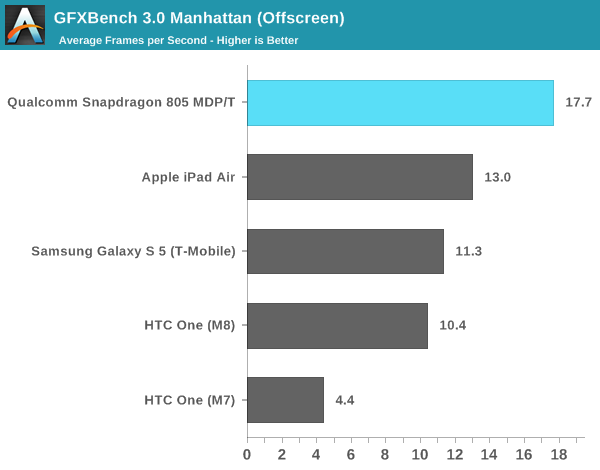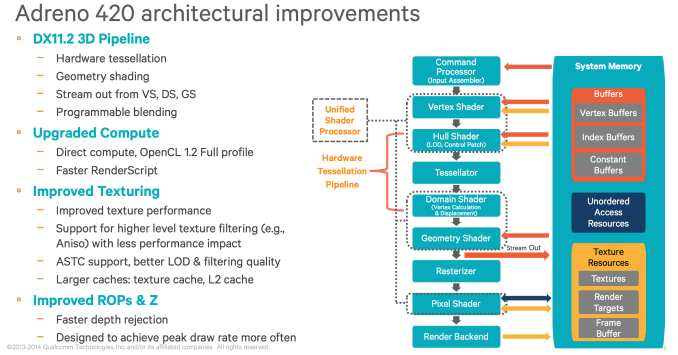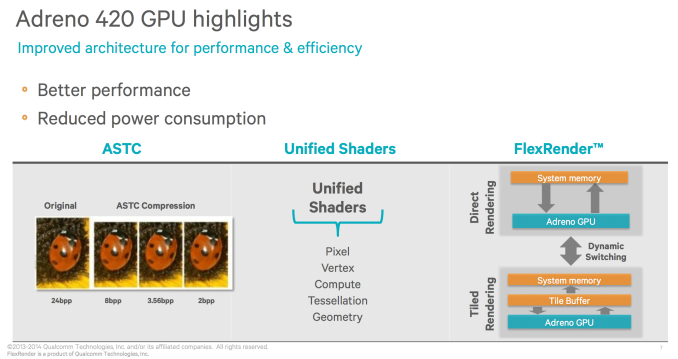Google I/O: Qualcomm Celebrates Launch of Adreno 420 GPU for Android Gaming
by Ryan Smith on June 23, 2014 1:00 PM EST
With Google’s annual I/O developers’ conference taking place this week, this should end up being a busy week for Android news. The conference itself doesn’t officially start until Wednesday the 25th this year, but several partners are already chomping at the bit to get going. First among these will be Qualcomm, who will be using the backdrop of the I/O conference to celebrate the launch of their latest high-performance SoC-class GPU, the Adreno 420.
Adreno 420 is the first member of Qualcomm’s next-generation SoC GPU family to make it out the door and in to a finished product, bringing with it OpenGL ES 3.1 and Direct3D 11 functionality. First announced last year as part of the Snapdragon 805 SoC, Snapdragon 805 and by extension Adreno 420 is now shipping in Samsung’s just-announced Galaxy S5 Broadband LTE-A. The S5B marks the first Adreno 420 product to reach consumer hands, and for as much as an SoC can have a formal launch this would be it, with Qualcomm celebrating its launch coinciding with this year’s Google I/O conference.
For Qualcomm the Adreno 420 in particular is an especially big deal since it is the first GPU to ship based on the Adreno 400 architecture. The Adreno 400 architecture marks a significant advancement in the feature set of Qualcomm’s GPUs, bringing Qualcomm’s latest architecture generally up to par with the existing desktop GPUs by integrating full Direct3D feature level 11_2 functionality alongside the more mobile-focused OpenGL ES 3.1 feature set. By doing so Qualcomm has reached feature parity with desktop GPUs (for the time being), even slightly exceeding NVIDIA’s GPUs by Direct3D standards due to being an FL 11_2 architecture versus NVIDIA’s FL 11_0 architecture.
As we have already covered Adreno 420 in some depth last month we won’t spend too much time going over it now, though admittedly this is also partially due to the fact that Qualcomm is remaining tight lipped about the Adreno 400 architecture beyond a high-level feature standpoint. In brief the Adreno 400 architecture (and Adreno 420) is a full Direct3D FL 11_2 implementation, utilizing a unified shader architecture along with the appropriate feature additions. New to the Adreno 400 architecture is support for tessellation, including the necessary hull and domain shader stages, and as a Direct3D 11 product this would also include with it other Direct3D 11 features such as compute shaders and draw indirect support.
Meanwhile on the OpenGL ES side of matters, while ES 3.1 is not as expansive as Direct3D 11, this none the less means that the Adreno 400 architecture brings with it ES 3.1 functionality along with a number of its Direct3D-derrived features as extensions. Mobile developers will also be happy to hear that this is the first Qualcomm product to support adaptive scalable texture compression (ASTC), the OpenGL next-generation compression technology that should further improve, unify, and simplify the use of compressed textures on mobile platforms.
For Google I/O we are expecting Qualcomm to be heavily promoting the Android gaming possibilities of the Adreno 420 and the Snapdragon 805. The low power nature of mobile devices and the SoCs that power them means that while Qualcomm can’t match the performance of the larger desktop GPUs, Adreno 420 will be a big step up from the performance offered by the older Adreno 330 GPU. But more importantly for Qualcomm, they can do something that hasn’t been done before by bringing desktop-level features to Android devices.

From our May 2014 Snapdragon 805 Preview
In a sense this will be a repeat of the launch of Direct3D 11 on the desktop, except now with Qualcomm (and eventually other vendors) promoting the advanced features offered by these devices, throwing out examples and tools at developers to entice them to write games for this latest generation of hardware, and to otherwise put it to good use. Even without being able to match desktop processors, there are a number of effects that are made available (or at least more practical) via these new features, and can be used effective on mobile hardware. From a practical perspective Qualcomm should be able to offer Android developers the base graphics functionality of the current generation consoles at performance levels similar to the previous generation consoles.
Source: Qualcomm












65 Comments
View All Comments
eddman - Tuesday, June 24, 2014 - link
I think you guys are misinterpreting the figures.In figure 5, it says "Tegra K1 delivers higher performance while consuming same power as A7".
What I gather from that is that K1 will consume less power than an A7 if performance was to be the same, IINM.
If that turns out to be the case and since A7 is efficient enough to be in a phone, then it should be possible to put a K1 in a phone too.
wicketr - Monday, June 23, 2014 - link
Damn. 4x faster than my M7 and my device is barely 12 months old. That's insane.jwcalla - Monday, June 23, 2014 - link
Title: Qualcomm Launches GPU for Android GamingIn this article: Direct3D this, Direct3D that.
Not to pick on the author because Qualcomm loves to talk about D3D in all their announcements... but why? D3D has practically no adoption in mobile at this time -- none; and even MS seems to be de-emphasizing Win RT for their tablets.
From a mobile perspective, what really matters is how well their Open GL/ES implementations are.
ArthurG - Monday, June 23, 2014 - link
Very true, this article talks mainly about D3D... in Android Gaming !And regarding Qualcomm OpenGL, it's subpart, broken and papersheet features without any dev support, even in their own forum... compared to Nvidia, it's a joke
Ryan Smith - Monday, June 23, 2014 - link
The Direct3D talk is due to the fact that this is how we classify GPU feature sets at the moment. Direct3D offers a larger feature set than OpenGL ES 3.1, so once you exceed 3.1's feature set you need another way to classify them.jwcalla - Monday, June 23, 2014 - link
Wouldn't it be better to specify the features by name like multidraw indirect or bindless textures or whatever? How many people know what feature sets constitute D3D 11_2?Ryan Smith - Tuesday, June 24, 2014 - link
At the end of the day more people will understand and appreciate something like D3D FL 11_2 than they would draw indirect, scatter/gather, or bindless resources.This problem will eventually go away when OpenGL ES catches up and these features become part of the standard.
TheJian - Friday, June 27, 2014 - link
K1 supports OpenGL 4.4 also. Classified now as above Qcom for Android purposes correct? Direct3D talk is pointless in a MOBILE world ruled by android/iOS. Once again taking a shot at NV for, well no reason but that AMD portal ;) Let me know when DX works on android or iOS :) Until then only OpenGL ES3.1/OpenGL 4.4 matter right? Or are you saying Winrt has a huge market now? I must have missed that if it happened overnight.Madpacket - Tuesday, June 24, 2014 - link
+1Like who really cares about D3X features for an ASIC that will power Android devices? The 5 people who bought RT devices?
ArthurG - Monday, June 23, 2014 - link
Is it a publi-reportage for QC or what ?Only one mention of Tegra K1 to say that the Andreno feature set is higher (which is not true). Why don't you say that 420 doesn't support full OpenGL 4.4 like K1 ? Why don't you say that 805 is limited to Android and maybe WinRT when K1 support all of that plus Linux (ubuntu) ? Why don't you say that Adreno drivers s*cks big time compared to Nvidia golden standard ?
But more important, what don't say that Adreno 420 is completely destroyed in performance by K1 ?
very very oriented article :(